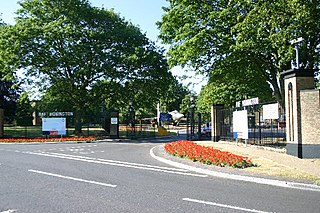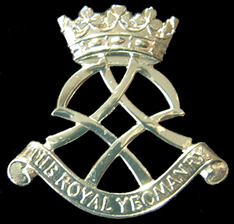
The Army Air Corps (AAC) is the aviation arm of the British Army, first formed in 1942 during the Second World War by grouping the various airborne units of the British Army. Today, there are eight regiments of the AAC, as well as two independent flights and two independent squadrons deployed in support of British Army operations around the world. Regiments and flights are located in the United Kingdom, Kenya, and Canada. Some AAC squadrons provide the air assault elements of 16 Air Assault Brigade, through Joint Helicopter Command.

Chemical, biological, radiological and nuclear defense or NBC protection is protective measures taken in situations in which chemical, biological, radiological or nuclear hazards may be present. CBRN defense consists of CBRN passive protection, contamination avoidance, and weapons of mass destruction mitigation.

The Royal Air Force Regiment is part of the Royal Air Force and functions as a specialist corps. Founded by Royal Warrant in 1942, the Corps carries out soldiering tasks relating to the delivery of air power. Examples of such tasks are non-combatant evacuation operation (NEO), recovery of downed aircrew, and in-depth defence of airfields by way of aggressively patrolling and actively seeking out infiltrators in a large area surrounding airfields. In addition the RAF Regiment provides Joint Terminal Attack Controllers (JTACs) to the British Army in the Tactical Air Control Party (TACP) role, and provides flight size commitment to the Special Forces Support Group.

Royal Air Force Honington or more simply RAF Honington is a Royal Air Force station located 6 mi (9.7 km) south of Thetford near Ixworth in Suffolk, England. It was used as a bomber station during the Second World War and through the Cold War, hosting Handley Page Victors and Hawker Siddeley (Blackburn) Buccaneers. RAF Honington has been the RAF Regiment depot since 1994.

The Joint Chemical, Biological, Radiological and Nuclear Regiment was a specialist expeditionary unit of the British armed forces. Personnel of the Joint CBRN Regiment were trained in the detection, identification and monitoring of nuclear, biological and chemical weapons.

The Royal Yeomanry (RY) is the senior reserve cavalry regiment of the British Army. Equipped with Supacat Jackal variants, their role is to conduct mounted and dismounted formation reconnaissance. The Regimental Headquarters is located in Leicester, with squadrons in Fulham, Nottingham, Dudley, Croydon, Telford, and Leicester. The regiment is part of the Royal Armoured Corps and is only reserve cavalry regiment to resubordinate into regular brigade as part of the Future Soldier Programme, which in turn arose from the Integrated Review of Security, Defence, Development and Foreign Policy published in March 2021.

The Special Operations Engineer Regiment (SOER) is a specialised unit of the Australian Army. The regiment forms part of the Special Operations Command. The unit was formed in 2002 as the Incident Response Regiment (IRR), they are deployed to respond to chemical, biological, radiological, nuclear or explosive incidents. The regiment was transferred into the newly raised Special Operations Command in 2003. In 2010 and 2011, its role changed to supporting the army's special forces units, and it was renamed accordingly.

Canadian Special Operations Forces Command is a command of the Canadian Armed Forces. It is responsible for all special forces operations that respond to terrorism and threats to Canadians and Canadian interests around the world.

No. 504 Squadron was one of the Special Reserve Squadrons of the Auxiliary Air Force, and today is a reserve force of the RAF Regiment. It was integrated into the AAF proper in 1936. Based at RAF Cottesmore, Rutland, 504 Squadron used a variety of light bombers before being re-tasked to fighters with the Hawker Hurricane in 1939. It subsequently became a Fighter Squadron. Currently No. 504 Squadron no longer has a flying role, but as part of No 85 Expeditionary Logistics Wing of the RAF A4 Force.

The Defence Chemical, Biological, Radiological and Nuclear Centre is a United Kingdom military facility at Winterbourne Gunner in Wiltshire, south of Porton Down and about 4 miles (6 km) north-east of Salisbury. It is a tri-service location, with the Army being the lead service. The centre is responsible for all training issues relating to chemical, biological, radiological and nuclear (CBRN) defence and warfare for the UK's armed forces.

No. 26 Squadron RAF Regiment was an RAF Regiment Field Squadron between 1951 and 2008. It was reformed in 2010 as a specialist Chemical, Biological, Radiological and Nuclear (CBRN) Squadron initially based at RAF Honington in Suffolk. When it was a Field Squadron, it served at locations such as RAF Abu Sueir, RAF Habbaniya, RAF Amman, RAF Tymbou, RAF Nicosia, RAF Changi, RAF Bicester, RAF Gutersloh and RAF Laarbruch. It took part in Operation's Granby and Desert Storm in 1990-91 and latterly it was based at RAF Waddington as a Rapier Squadron.
Jason Paul Sutton, OBE, is a Royal Air Force Regiment officer who was appointed Officer of the Order of the British Empire for his actions whilst serving in Iraq in 2007.
No. 2623 Squadron RAuxAF Regiment is a Royal Auxiliary Air Force RAF Regiment reserve squadron based at RAF Honington. It was formed on 1 July 1979 to provide ground defence of the station. Tasked with preventing Soviet Special Forces from disrupting flying operations, personnel were recruited from across East Anglia and formed an integral part of the station's war-fighting capability for the next 15 years. Throughout this period, the squadron participated in many exercises and held annual camps in the United Kingdom, Germany and Gibraltar, winning the Strickland Trophy competition in 1991.

3 RegimentArmy Air Corps is a regiment of the British Army and is part of the 1st Aviation Brigade Combat Team and Joint Helicopter Command (JHC). 3AAC is based at Wattisham Flying Station in Suffolk, England. This regiment operates the AgustaWestland Apache AH1 and AH-64E Apache attack helicopters.
No. 660 Squadron AAC is a squadron of the British Army's Army Air Corps (AAC). The squadron traces its lineage to a Royal Air Force squadron that existed during the Second World War. In the late 1950s the squadron's numerical was transferred to the AAC and since its formation in 1969, it has operated as a British Army unit flying various types of battlefield helicopters. The squadron has been re-formed and disbanded on a number of occasions. The squadron is currently based at RAF Shawbury where it forms part of No. 1 Flying Training School, but it has been deployed operationally to Northern Ireland, Hong Kong and Brunei throughout its existence.
5 Regiment Army Air Corps is a regiment of the British Army and is part of the Joint Helicopter Command (JHC). The regiment is based in Northern Ireland at JHC Flying Station Aldergrove.
This is a list of units of the British Army's Royal Engineers.

No. 5131 (BD) Squadron was an Explosive Ordnance Disposal (EOD) squadron of the Royal Air Force. First formed in 1943, 5131 Bomb Disposal Squadron was the Royal Air Force’s explosive ordnance disposal capability for 77 years. Its technicians were trained to deal with conventional munitions, chemical munitions and improvised explosive devices. The Squadron also responded to aircraft crashes; clearing the area of explosive risks and making any ordnance, aircraft assisted escape systems and flare countermeasures safe. During the 77-year operational history of the squadron, it saw action in World War II, the Suez conflict, the Indonesian conflict, the Cyprus invasion, the Falkland Islands war, Kosovo, Bosnia, Iraq, Afghanistan and Northern Ireland as well as Military Assistance to Police taskings in the UK.
28 Engineer Regiment (C-CBRN), Royal Engineers is a regiment of the British Army that focuses on countering chemical, biological, radiological and nuclear (C-CBRN) hazards in the environment. Its operational chain of command is 29 Group, under 8th Engineer Brigade as part of 1st (UK) Division.














